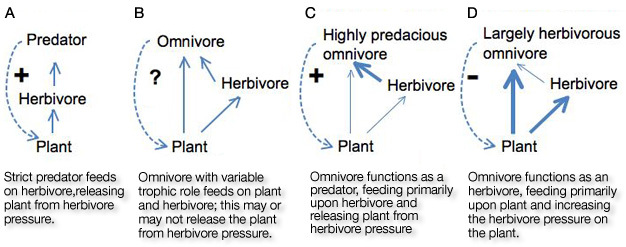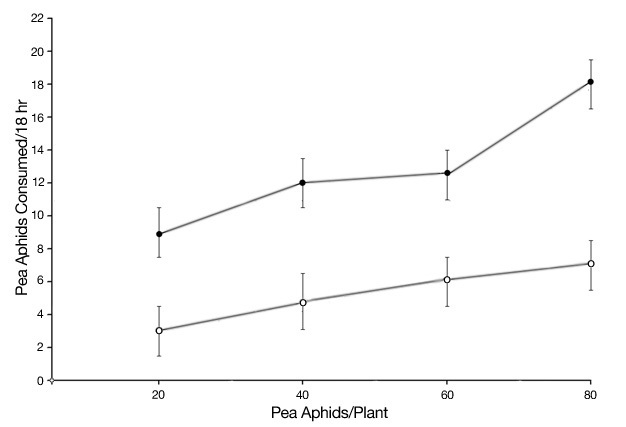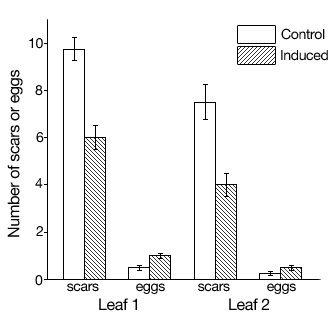« Prev Next »

In natural and agricultural ecosystems, omnivorous insects are omnipresent. Whether they are 'true omnivores' that require both plant and prey resources to complete their life-cycle, 'herbivores' that occasionally or incidentally consume prey, or 'predators' that drink plant-provided nectar, insect omnivores are a key part of any ecosystem. More than 40 families of insects from over 12 orders are described as omnivorous (Coll & Guershon 2002). Many insects are life-history omnivores, which means that they act as herbivores during one stage of their life, then as predators during another. For example, most parasitoid wasps feed upon their host (another arthropod) during larval development, and then nectar-feed as adults. The more omnipresent form of omnivory in insects, which will be the focus of this article, is when insects consume plant and prey resources during the same developmental stage. These insects consume prey to varying extents, and utilize plant resources in diverse ways, some directly feeding on plant tissues (e.g. true bugs) and others just on nectar (e.g. wasps and ants). Despite their prevalence and ecological importance, ecologists have a hard time incorporating insect omnivores into trophic webs or other ecological models (Polis & Strong 1995). Consuming both plant and prey resources, omnivores function both as 'herbivores' and as 'predators', so they can, respectively, decrease or increase the strength of trophic cascades (Figure 1). The dynamic trophic role that omnivorous insects occupy raises important questions: what environmental factors cause an omnivore to decide to consume plant versus prey resources? How does this trophic role affect the community of organisms in which the omnivore lives? How can humans best utilize omnivorous insects in the biological control of pests?

Ecology and Evolution of Insect Omnivory
Omnivory as an adaptation by herbivores to obtain sufficient nutrients.
An alternative to these adaptations, utilized by omnivorous insects, is to supplement plant-derived food resources with protein-rich prey. However, in order to obtain prey items an insect must be able to locate, capture, consume, and digest the prey. This often requires adaptations such as acute vision, special mouthpart morphology, venom, and proteinases for digestion. Since capturing a prey item is generally more difficult than feeding from a suitable host plant, prey-hunting by omnivores is more common when protein access from their host plant is insufficient. As such, host plant quality determines the extent to which omnivores hunt prey, which defines their trophic role as herbivore or predator. An experiment conducted by Eubanks and Denno (2000) confirms this prediction. The big-eyed bug Geocoris punctipes is a generalist omnivore that feeds on a range of herbivores, including aphids. Eubanks and Denno manipulated the availability of protein-rich pea pods to Geocoris, and then measured the amount of aphids consumed. As predicted, bugs that consumed the protein-rich pea pods hunted for less prey compared with bugs without access to the pea pods (Figure 2).

Eubanks and Denno demonstrated that host plant quality determines the trophic role taken by omnivorous insects. From the perspective of the plant, the degree to which a resident omnivore feeds on the plant itself versus the herbivores that consume the plant has important fitness consequences. Agrawal et al. (1999) demonstrated that plants can manipulate the degree to which their resident omnivores consume prey by inducing defensive responses that lower the quality of the plant resource available to the omnivores. To demonstrate this, Agrawal et al. experimentally inflicted herbivore damage on young cotton plants. After removing the herbivores, damaged plants were allowed to grow for a period of time before herbivores and omnivores were placed on them. Cotton responds to herbivore damage by inducing chemical changes that reduces its palatability (e.g., Karban 1997). They then measured the degree to which omnivores fed on plant versus prey resources on induced and un-induced plants. They found that omnivores on induced cotton plants not only fed less on the cotton, but also consumed more of its herbivores (Figure 3). This study, and prior work on the topic have been carried out in agricultural systems, in which the interacting species often lack a long evolutionary history. We currently have a very limited understanding as to what extent plants manipulate the foraging behavior of their resident omnivores in nature, where greater specialization is likely. The exception to this rule is ant-plant mutualisms, which have been widely studied and yielded fascinating insights.

Omnivory as part of a mutualistic relationship between plant and predator.
Importance of Insect Omnivores in Agriculture
2 Why omnivores are effective at suppressing pest populations.
Use of floral nectar to attract 'predators' and parasitoids.
As mentioned above, many insects that are classically considered predators also consume plant-provided nectar. For example, nectar fuels the foraging efforts of predatory and parasitic wasps, both of which are important agents of biological pest control. Many farmers plant rows of flowering plants among their crops to attract these beneficial insects (Landis et al. 2000). Nectar not only attracts the natural enemies of many agricultural pests to the farm landscape, but also increases their foraging efficiency and longevity once they have arrived.
Conclusion
Glossary
Trophic webs: The feeding relationships between organisms in a population.
Ecological models: Mathematical representations of ecological processes. Ecologists use ecological models to understand complex processes. Model validity refers to how accurately the ecological model estimates real processes.
Trophic cascades: When predators in a trophic web suppress the abundance of their prey, the result is a smaller prey population. As a result, the prey of the prey (plants if the prey is an herbivore, or other animals if it is a predator) is released from predation pressure and increases in abundance.
Biological control of insect pests: In agriculture, pests can be controlled by the use of chemical or biological tools. In biological control, natural biological processes are utilized to control pests; predatory insects and insect diseases are two commonly used tools of biological control.
Endosymbiotic microbes: An endosymbiont is an organism that lives inside the body of another organism. Many insects have microbes that live in their guts and aid in food digestion while additionally providing their hosts with valuable by-products, such as protein.
Nutrients: Chemicals that organisms need to grow and survive. Ecologists and entomologists usually use the word nutrient to mean protein, or other nitrogen-rich compounds that are usually hard for insects to come by.
Phloem: In vascular plants the phloem is the living tissue that transports photosynthates (sugary compounds) throughout the plant. Phloem tends to be high in sugar and low in protein.
Proteinases: A compound needed for the digestion of protein compounds. Proteinases are proteases that begin the hydrolytic breakdown of proteins, usually by splitting them into polypeptide chains.
Inducible plant responses: Plants respond to external and internal stimuli by changing their structural and chemical composition. For example, plants usually respond to damage from herbivores by increasing the production of chemical defenses and toxins in order to prevent subsequent damage by the herbivore.
Ant-plant mutualisms: Mutually beneficial interactions between ants and plants. There is a wide range of ant-plant mutualisms over a spectrum of specialization, from loose, temporary associations to life-long obligate relationships.
Extrafloral nectar: Sugary compounds produced by plants outside of the inflorescence. These sugar gifts function to attract beneficial insects such as ants and wasps to the plant, usually to increase the predation rate of herbivores also found on the plant. Omnivores, which feed on plant and prey, are able to utilize the nectar as fuel to hunt for prey.
Natural enemies: The natural predators of other organisms (typically predators of insect pests on farms). As such, attracting natural enemies to the farm can be beneficial if it increases predation upon the pests.
Dicyphini: A tribe of plant bugs (family: Miridae) in the subfamily Bryocorinae. Many dicyphine plant bugs are highly predatory omnivores, and tend to be specialized to hairy, or hairy-sticky plants. These insects are important agents of biological control on many greenhouse crops.
Solanaceae: A family of flowering plants used in agriculture and medicine, including tomato, pepper, potato, eggplant, and many more.
References and Recommended Reading
Agrawal, A. A., Kobayashi, C., & Thaler, J. S. Influence of prey availability and induced host plant resistance on omnivory by western flower thrips. Ecology 80, 518-523 (1999).
Coll, M., & Guershon, M. Omnivory in terrestrial arthropods: mixing plant and prey diets. Annual Review of Entomology 47, 267-297 (2002).
Douglas, A. E. Nutritional interactions in insect-microbial symbioses: aphids and their symbiotic bacteria Buchnera. Annual Review of Entomology 43, 17-37 (1998).
Eubanks, M. D., & Denno, R. F. Host plants mediate omnivore-herbivore interactions and influence prey suppression. Ecology 81, 936-947 (2000).
Eubanks, M. D., Styrsky, J. D., & Denno, R. F. The evolution of omnivory in heteropteran insects. Ecology 84, 2549-2556 (2003).
Karban, R., & Baldwin, I. T. Induced Responses to Herbivory. Chicago, IL: University of Chicago Press, 1997.
Lalonde, R. G., McGregor, R. R., & Gillespie, D. R. Plant-feeding by arthropod predators contributes to the stability of predator-prey population dynamics. Oikos 87, 603-608 (1999).
Landis, D. A., Wratten, S. D., & Gurr, G. M. Habitat management to conserve natural enemies of arthropod pests in agriculture. Annual Review of Entomology 45, 175-201 (2000).
Ness, J. H., Morris, W. F. & Bronstein, J. L. For ant-protected plants, the best defense is a hungry offense. Ecology 90, 2823-2831 (2009).
Polis, G. A. & Strong, D. R. Food web complexity and community dynamics. The American Naturalist 147, 813-846 (1995).
Wheeler, A. G. Biology of the Plant Bugs. Ithaca, NY: Cornell University Press, 2001.






























